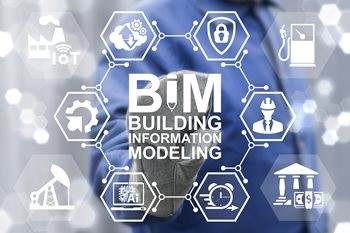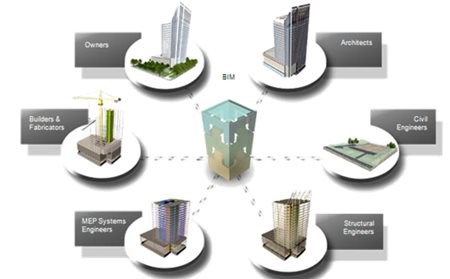Cracks in the System
Cybersecurity threats don’t always kick the door down—sometimes, they slip in through the cracks. This month, we’re spotlighting three subtle but serious security risks that could be undermining your defences right now.

This article will explore how Autodesk are enabling simple to deploy technology solutions and process, while at the same time our industry governance groups are putting clear standards around information management and collaborative process.

Centralisation and data: two of the recurring words I heard at Autodesk University 2018. It’s quite clear that Autodesk, and they have my full support on this, see the centralisation of your information as a critical success factor in improving the efficiency and effectiveness of the industry, not just individual teams.
Technology Developments
We’ve seen the benefits of centralising information at a software platform level through Building Information Models (BIM). Within an Autodesk Revit or Autodesk Civil 3D model we know we can produce drawings, schedules, visualisations, and the use of information for analysis and so on. We know all drawings, views, schedules are created from a single source, the parametric 3D model. This makes us more efficient at producing our drawing deliverables. According to the NBS BIM Report of 2018, a sizeable majority, around 74% of the UK Construction industry, now utilise Building Information Modelling in some capacity. In 2015, it was 48% and 2011 just 13%. It's a brilliant success story.
 The critical component of BIM, the actual information on the building or infrastructure assets, is usually contained within the software application. This is difficult to access unless you have significant expertise in a software package. It’s often standardised for use within our teams, but not for collaborative use. This is starting to change, and client driven process requirements like BIM Level 2 (soon to be ISO9650) within the UK, connects information from the design (stage 1-4) and construction stages (5-6) to create a digital archive, as well as for use within preventative maintenance strategies during building operation (stage 7). Even this process can be challenging to centralisation; it’s difficult to maintain information over time, through multiple systems, and to be able to check this information for consistency and against criteria. This leads to falling back on quite low-tech solutions, such as exchanging information in spreadsheets and trying to manage the information within complex property systems with 3D models, that are simply not designed for this purpose. Finally, we still don't generally utilise documentation and information across industries for better decision making. Having a bigger picture view could allow us to see more site issues, health and safety considerations, design inefficiencies and pinch points. Instead, information is frequently recreated in silos, often simply because we can't access the information when we need it, where we need it and in the manner that we need it in. We lose information and rebuild it all the time within this industry and for me, this is undoubtedly the single most costly process we have. Good information and document management across the industry supported by Common Data Process and Platforms, which together form our ‘Common Data Environment (CDE)’ is key.
The critical component of BIM, the actual information on the building or infrastructure assets, is usually contained within the software application. This is difficult to access unless you have significant expertise in a software package. It’s often standardised for use within our teams, but not for collaborative use. This is starting to change, and client driven process requirements like BIM Level 2 (soon to be ISO9650) within the UK, connects information from the design (stage 1-4) and construction stages (5-6) to create a digital archive, as well as for use within preventative maintenance strategies during building operation (stage 7). Even this process can be challenging to centralisation; it’s difficult to maintain information over time, through multiple systems, and to be able to check this information for consistency and against criteria. This leads to falling back on quite low-tech solutions, such as exchanging information in spreadsheets and trying to manage the information within complex property systems with 3D models, that are simply not designed for this purpose. Finally, we still don't generally utilise documentation and information across industries for better decision making. Having a bigger picture view could allow us to see more site issues, health and safety considerations, design inefficiencies and pinch points. Instead, information is frequently recreated in silos, often simply because we can't access the information when we need it, where we need it and in the manner that we need it in. We lose information and rebuild it all the time within this industry and for me, this is undoubtedly the single most costly process we have. Good information and document management across the industry supported by Common Data Process and Platforms, which together form our ‘Common Data Environment (CDE)’ is key.
It's heartening to see that Autodesk, as a technology provider, really recognises this challenge. Indeed, that it’s not just about storage, but rather the management of this information within a collaborative process and it’s use. Autodesk’s approach is to provide eco-systems; providing a centralised operating system for construction. Much like smartphone operating systems, it contains tool sets for all sorts of applications, which communicate with each other. Solutions such as Autodesk BIM 360 support many tasks present within design, construction and operation via a similar approach. Like your phone, additional functionality can be installed in the form of apps. With a bit of programming knowledge, like your phone or tablet, we can even develop our own solutions, something most of us do less frequently, if at all, but it’s good to know we can secure this service if needed.
 With BIM 360, the first product you’ll probably see is BIM 360 Document Management. A very capable solution, providing mobile access to complex design files. This allows for the management of documentation through useful tool sets such as mark up, issue management, RFIs and so forth. But consider this a gateway to an ecosystem. For the real power of the solution, start looking at the apps Autodesk can provide.
With BIM 360, the first product you’ll probably see is BIM 360 Document Management. A very capable solution, providing mobile access to complex design files. This allows for the management of documentation through useful tool sets such as mark up, issue management, RFIs and so forth. But consider this a gateway to an ecosystem. For the real power of the solution, start looking at the apps Autodesk can provide.
In BIM 360 Design, we already have tools to enable design teams that utilise Autodesk Revit to collaborate with one another by hosting the models on BIM 360. Design collaboration allows multi-disciplined teams of Revit users to see each other’s changes within a timeline and make comments within a centralised environment. Now we believe this will be further enhanced by bringing in Civil 3D, Plant 3D and AutoCAD users to these workflows. Bear in mind that we are talking about being able to collaborate complex design files, which are often entirely in different systems, and being able to bring these together in a dynamic way, directly from the author into a centralised location, and being able to see changes at milestones on a project. Don’t underestimate the world of possibility that being able to see complex work in progress design files without the need for complex tools brings. All we need is a web browser or a tablet and a few navigation tools that can be learnt quickly to be able to; access and view all the drawings and models; see all the enclosed information and changes between versions; mark-up functionality; and communicate with team members. It’s impressive in its simplicity. BIM 360 Design is a little bit ‘Autodoesk-centric’ now, but as the keynote speech mentioned at the conference, Autodesk do realise they can’t act as an island where it comes to centralised information management. We anticipate that Autodesk are likely to add additional formats including OpenBIM formats such as IFC to these solutions within 2019.
Connecting Information
2 years ago, at Autodesk University, we heard about platforms like Autodesk Quantum, a tool for connecting not entire software, but individual functions of software together through the Autodesk Forge platform. At the recent 2018 conference, Autodesk’s vision of the future is centralisation, connection, standardisation and management, and subsequent use and analysis of information.
Consider being able to have access to product libraries from manufacturers, not just of geometric information, but also of maintained product information. Being able to choose what information you bring into your design files, or your construction datasets. Imagine being able to link your model’s information to Google Spreadsheets; enabling non-design platform users to create schedules; or toolsets like PowerBI to allow BIM Managers to actively monitor the performance of their Building Information Models. The possibilities are huge, but only if our information is centralised.
We are seeing Autodesk really double down on this idea of centralisation in their recent acquisitions. For example, Assemble, a web-based solution for general contractors that provides real-time access to critical project data directly from 3D models. This solution allows contractors to engage in bid management, estimating, scheduling, site management and finance planning. Or the soon to be released BIM 360 Cost Management tools, which allows you to manage the cost and budget changes on your project from an online environment. It allows you to coordinate change orders and understand the financial impact of each change to the project’s bottom line. If you consider that you have tools like BIM 360 Design, BIM 360 Document Management, which host our models and associated data, sitting in the same ecosystem as BIM 360 Cost Management, and I’m sure presently, Assemble, you can start to foresee workflows where we are able to quantify directly from models, and directly report this information into tools to report and coordinate financial planning.
 While this is happening, we are seeing a huge focus on connecting design to construction at a technological level. Something desperately overdue in my opinion. I frequently see fantastic work within the design phase around modelling and decision making, only for the information to be dumbed down in construction. Or I observe construction teams struggle with complex BIM design software like Revit, in ways it probably wasn’t ever designed for. For example, making construction teams input information into Revit models for the purpose of clients’ preventative maintenance programs, or to report clashes on site to designers, or to capture snagging issues and report them within a graphical way. So, it’s great to see a phenomenal amount of development in packages like BIM 360 Build and BIM 360 Glue.
While this is happening, we are seeing a huge focus on connecting design to construction at a technological level. Something desperately overdue in my opinion. I frequently see fantastic work within the design phase around modelling and decision making, only for the information to be dumbed down in construction. Or I observe construction teams struggle with complex BIM design software like Revit, in ways it probably wasn’t ever designed for. For example, making construction teams input information into Revit models for the purpose of clients’ preventative maintenance programs, or to report clashes on site to designers, or to capture snagging issues and report them within a graphical way. So, it’s great to see a phenomenal amount of development in packages like BIM 360 Build and BIM 360 Glue.
BIM 360 Glue, for example, allows us to aggregate the Building Information Models together in order to understand coordination issues that may exist on site, and to be able to report these issues back to the designers. Glue is likely to be further enhanced to allow for more sophisticated reporting, dashboarding, analytics, and clash pinpointing within the original design offering software. This may be achieved through a combination of application development and support for open collaboration formats such as BCF (BIM Collaboration Format).
Tools such as BIM 360 Build, allow us to bring our design documentation into the field via mobile applications. This allows us to improve construction quality control and reduce rework. It allows us to form standard checklists to improve jobsite safety programme conformance. Most importantly, through the creation of all this information in a centralised environment against the design documentation, we start to build a compelling database. This database can be used to provide real insights into our construction project. These insights can help improve not only the efficiency of the build, but critically can improve health and safety on site. BIM 360 Build already provides good visibility of this information, but I believe we will start to see much greater development of the analytical side of these platforms. It’s perfectly possible through advancements in machine learning and artificial intelligence that we will start to see algorithms used which can predict site issues and conformity problems before they occur on site.
We should therefore all be prepared for a more connected future. Where we are not limited to what Autodesk foresee, but the ability to add apps and develop. It may sound like it’s years away, but in one of the sessions at AU, it was said that over 166 countries, at the time of speaking (Nov ‘18), had users of Revit Cloud Sharing (part of BIM 360 Design). From these users there are over 24,000 active projects, and 140,000 models, which cover 3.5 million updates occurring each calendar month.
It’s certainly an exciting time to be engaged within the Autodesk world. If you have any queries related to BIM 360 or any other Autodesk products, then please get in touch. We look forward to working with you at Symetri on this journey.
Cybersecurity threats don’t always kick the door down—sometimes, they slip in through the cracks. This month, we’re spotlighting three subtle but serious security risks that could be undermining your defences right now.
As 2025 comes to a close, we’re looking back at some of the most impactful cyber threats of the year and more importantly, what they reveal about the challenges ahead. From ransomware tactics to AI-driven phishing and risky app integrations, this round-up highlights where businesses have been most vulnerable and how you can strengthen your defences in 2026.
Learn what Product Lifecycle Management (PLM) is and how it helps teams manage product data, processes, and collaboration across the lifecycle. Discover the key benefits and PLM tools driving innovation.
